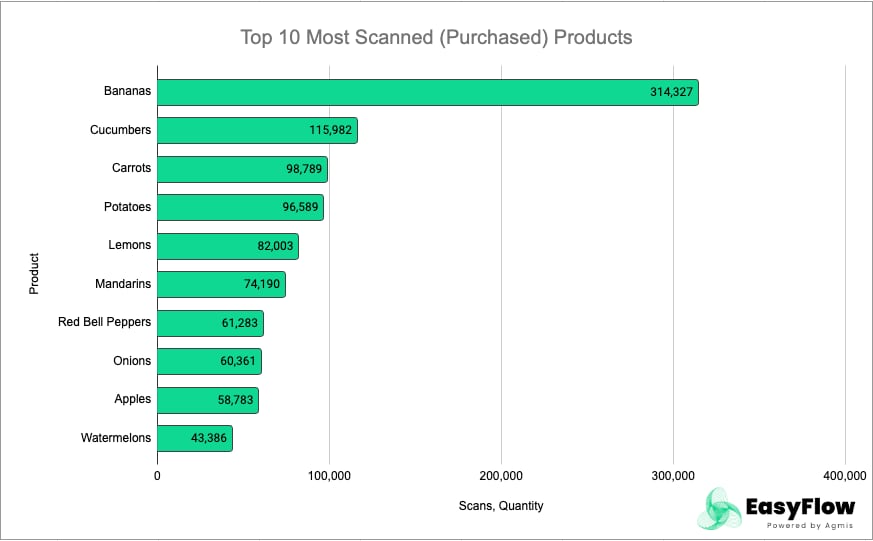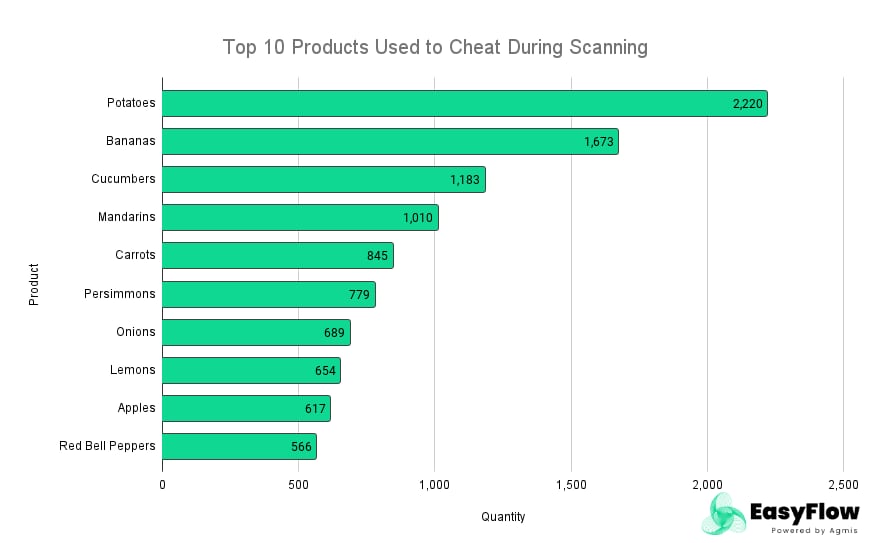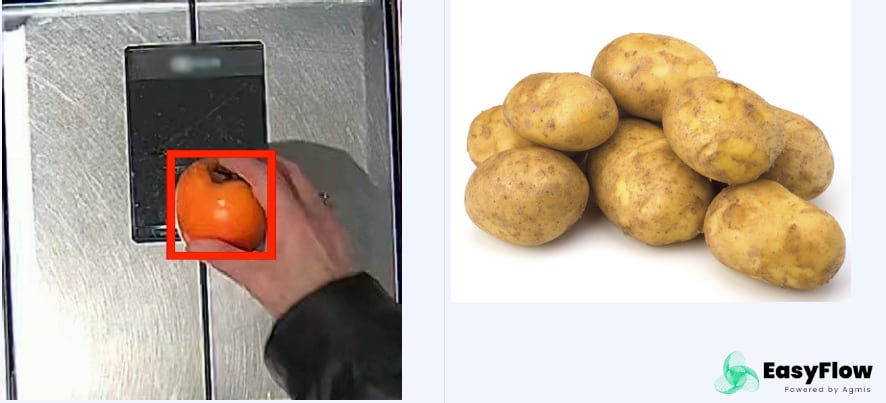EasyFlow.tech, in collaboration with ScanWatch.ai, conducted a study delving into data from 27 stores of a retail chain in Europe.
Our aim was to determine the impact of AI technology on shopping habits and theft trends in self-checkout stations.
Our intelligent video analytics technology, which leverages computer vision and artificial intelligence (AI), uses cameras at self-checkout stations to instantly recognize scanned items.
This is how we discovered some interesting data about common theft tactics, such as mislabeling high-value items as cheaper ones.
Our study reveals how some shoppers attempt to trick the system and how AI is making shopping more seamless and secure.
Analyzing Self-Checkout Statistics
In a Glance (2023 data)
Number of Stores: 27
Self-checkout stations: 162
AI-trained products monitored: 159
Total scanned products: 2,181,148
Total thefts: 32,107
In 2023, the deployment of AI-powered self-checkouts across 27 stores revealed intriguing statistics.
Over 2 million scanned items from the monitored list were processed, with AI models identifying 32,107 theft incidents.


Among the most frequently purchased items, bananas, cucumbers, and carrots topped the list, highlighting consumer preferences and the effectiveness of AI in managing inventory and checkout processes.
| Place | Product | Scans, Quantity |
|---|---|---|
| 1 | Bananas | 314,327 |
| 2 | Cucumbers | 115,982 |
| 3 | Carrots | 98,789 |
| 4 | Potatoes | 96,589 |
| 5 | Lemons | 82,003 |
| 6 | Mandarins | 74,190 |
| 7 | Red Bell Peppers | 61,283 |
| 8 | Onions | 60,361 |
| 9 | Apples | 58,783 |
| 10 | Watermelons | 43,386 |
Theft Trends at Self-Checkouts
The study further unveiled the most common products used to cheat during scanning, with potatoes, bananas, and cucumbers leading the chart.


This pattern underscores the role of AI in pinpointing specific theft trends, including the mislabeling of expensive items as cheaper alternatives—a tactic frequently observed with potatoes.
Such insights are crucial for retailers to devise targeted theft prevention strategies.
| Place | Product | Times Used to Cheat, Quantity |
|---|---|---|
| 1 | Potatoes | 2,220 |
| 2 | Bananas | 1,673 |
| 3 | Cucumbers | 1,183 |
| 4 | Mandarins | 1,010 |
| 5 | Carrots | 845 |
| 6 | Persimmons | 779 |
| 7 | Onions | 689 |
| 8 | Lemons | 654 |
| 9 | Apples | 617 |
| 10 | Red Bell Peppers | 566 |
What’s Hiding Behind The Potatoes?
Now, before we dive into the details, it’s important to note that Europeans have a strong affinity for potatoes, but this phenomenon is about more than just their love for spuds.
The potato deception is an unconventional practice where people intentionally label costly items as potatoes to pay a lower price, thereby saving money.












This term isn’t limited to potatoes alone; it includes a range of tricks. For example, expensive grapes pretend to be affordable carrots, prime steaks disguise themselves as ordinary potatoes, and barcodes from pricey items like wine, beer, cosmetics, and spirits are concealed with stickers taken from less expensive products.
Some of these tricks even have catchy names, like “the banana trick” (where steaks pose as potatoes) and “the switcheroo” (swapping expensive barcodes for cheaper ones).
This quirky trend has become a concern for retailers. It shows how creative people can be in outsmarting self-checkout systems.
The choice of potatoes as a cover for various items, from electronics to fancy foods, reflects Europe’s love for this humble vegetable and their desire to cut costs.
While this practice may lead to immediate financial losses through undercharging, it also creates chaos in inventory management and disrupts the supply chain, causing problems with sales data analysis.
Understanding this potato-themed theft trend is crucial for retailers, not only in Europe but worldwide.
It highlights the need for constant innovation in AI and machine learning to improve item recognition and combat these increasingly sophisticated theft methods.
So, while we share a chuckle over Europe’s potato passion and its colorful scam names, the way forward for retailers involves adopting AI-enhanced self-checkouts and continually fine-tuning these systems to stay ahead of the ever-evolving “Potato Deception”.
AI’s Impact on Theft Prevention
The application of AI at self-checkouts, as demonstrated by ScanWatch.ai’s platform, has significantly curtailed theft incidents.
By utilizing built-in checkout cameras, the AI model instantaneously recognizes scanned items, thereby deterring mislabeling and other forms of checkout fraud.
In fact, AI models identifying an impressive 32,107 theft incidents underscore the effectiveness of this technology.
There’s no turning back; AI is here and it’s performing exceptionally well. Sadly, brick-and-mortar stores are adopting this technology too slowly and are losing out because of it every day.
This reduction in theft rates not only enhances the customer experience by ensuring faster and more reliable checkouts but also protects the retailer’s bottom line.
The Rise of AI in Retail
The integration of AI in retail environments, especially at self-checkout stations, has marked a transformative period in the industry.
Retailers are increasingly leveraging AI to enhance customer service, streamline operations, and strengthen security measures.
This shift is part of a broader trend that sees the AI in Retail Market size estimated to balloon from USD 9.65 billion in 2024 to USD 38.92 billion by 2029, growing at a CAGR of 32.17% during the forecast period. 1
Our collaboration with ScanWatch.ai, a retail software aimed at minimizing losses and improving the shopper experience, stands as a prime example of AI’s practical application in combating checkout fraud.
Furthermore, our picklist assistant tool introduces another layer of innovation by streamlining the shopping process.
During a recent observation period, the picklist assistant facilitated 95,311 purchases with a remarkable 90% accuracy rate, reducing the average item-finding time at self-checkouts from 10 seconds to just 3 seconds. This not only elevates the customer experience but also showcases the significant operational efficiencies AI can bring to the retail sector.
The surge in AI adoption in retail is transforming the industry, enabling fantastic customer experiences, opportunities for revenue growth, rapid innovation, and smarter operations.
Machine learning and deep learning, the most commonly utilized AI technologies in retail, offer more personalized experiences to end-users and create an interactive environment.
Retailers are embracing computer vision to “see” and interpret visual information, opening up new possibilities in customer experience, demand forecasting, inventory management, and more.
Future Directions
Looking ahead to the future, AI-driven self-checkout systems are poised for remarkable advancements. The ongoing development of AI and machine learning technologies holds the promise of creating systems that excel in detecting theft and streamlining operations.
Pioneering initiatives like EasyFlow.tech’s retail crime predictor are leading the charge, striving to foresee and prevent retail crime by analyzing patterns and predicting potential theft events.
Furthermore, solutions such as the queue management system aim to transform the shopping experience by optimizing the checkout process and reducing waiting times, ultimately making shopping more efficient and enjoyable for customers. This system relies on AI to monitor queue lengths and wait times, adjusting checkout staffing in real-time to meet demand.
In addition, shelf performance analytics tool harnesses AI to keep an eye on shelf stock levels and product performance, ensuring that popular items remain available and easy to find. This not only boosts customer satisfaction but also helps prevent potential theft by ensuring that items are accurately priced and positioned.
The incorporation of these cutting-edge technologies into AI-powered self-checkout systems will empower retailers to stay ahead of security challenges while providing customers with enhanced shopping experiences.
Continuous analysis of theft trends and consumer behavior, powered by these advanced AI tools, will equip retailers with the insights required to adapt and thrive in the ever-changing retail landscape.
Conclusion
In conclusion, the incorporation of AI technology into self-checkout systems marks a significant stride in the retail industry’s battle against theft.
Retailers armed with AI-powered solutions, gain a substantial advantage in addressing theft incidents with remarkable precision and efficiency. As AI continues to advance, its influence on the future of retail security and operations holds the promise of being truly transformative and widespread.
This study of AI-powered self-checkout statistics and trends not only sheds light on the current state of theft prevention in retail but also offers a glimpse into the future.
It’s a future where technology and data unite to create safer and more efficient shopping environments, making the retail experience both more secure and enjoyable for all.
- https://www.mordorintelligence.com/industry-reports/artificial-intelligence-in-retail-market ↩︎
Curious About The Above Solution?
Chat with Vejūnė and explore your possibilities without any commitment.


Vėjūnė Krašinskienė
Chief Operating Officer
Book a no-obligation free consultation with our expert.











































